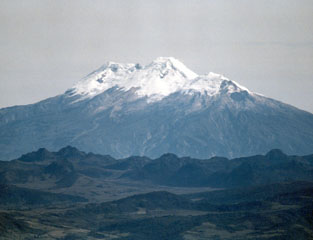Report on Nevado del Huila (Colombia) — 10 February-16 February 2010
Smithsonian Institution / US Geological Survey
Weekly Volcanic Activity Report, 10 February-16 February 2010
Managing Editor: Sally Sennert.
Please cite this report as:
Global Volcanism Program, 2010. Report on Nevado del Huila (Colombia) (Sennert, S, ed.). Weekly Volcanic Activity Report, 10 February-16 February 2010. Smithsonian Institution and US Geological Survey.
Nevado del Huila
Colombia
2.93°N, 76.03°W; summit elev. 5364 m
All times are local (unless otherwise noted)
INGEOMINAS reported that during 10-16 February whitish gas plumes from Nevado del Huila were seen through the web camera rising no more than 2 km above the lava domes. The rate of sulfur dioxide emissions was 945 and 4,130 tonnes per day on 10 and 16 February, respectively. During an overflight on 12 February scientists saw gas emissions and thermal anomalies on the high part of the dome. Based on analyses of images, the volume of the extruded lava dome was an estimated 70 million cubic meters. The Alert Level remained at III (Yellow; "changes in the behavior of volcanic activity").
Geological Summary. Nevado del Huila, the highest peak in the Colombian Andes, is an elongated N-S-trending volcanic chain mantled by a glacier icecap. The andesitic-dacitic volcano was constructed within a 10-km-wide caldera. Volcanism at Nevado del Huila has produced six volcanic cones whose ages in general migrated from south to north. The high point of the complex is Pico Central. Two glacier-free lava domes lie at the southern end of the volcanic complex. The first historical activity was an explosive eruption in the mid-16th century. Long-term, persistent steam columns had risen from Pico Central prior to the next eruption in 2007, when explosive activity was accompanied by damaging mudflows.

